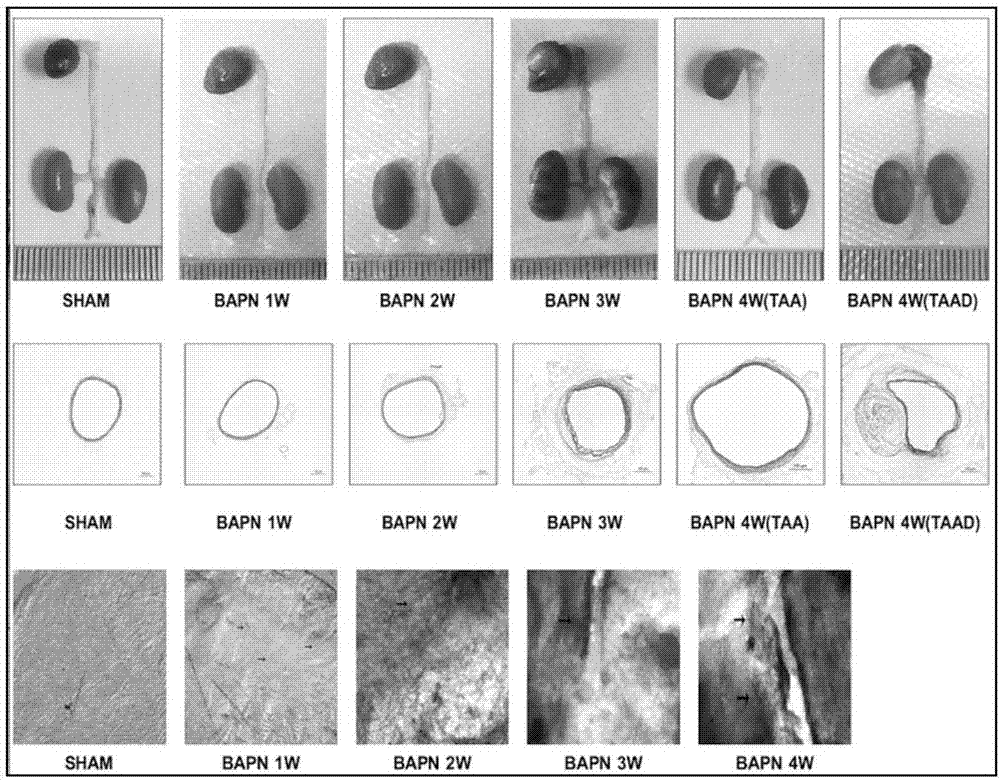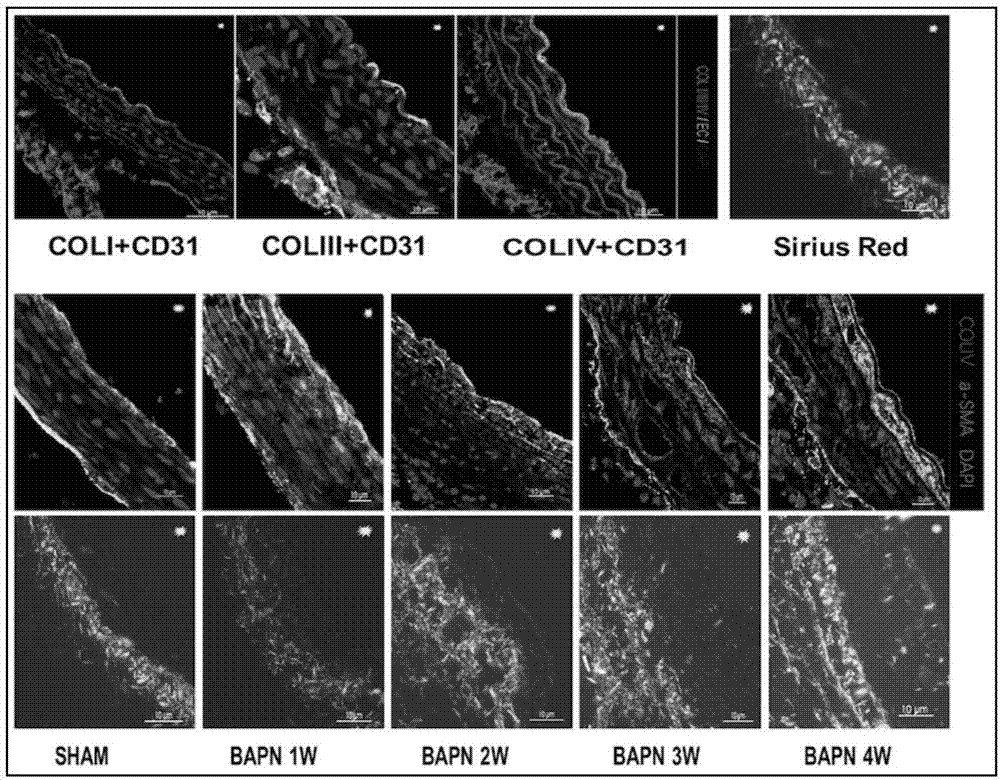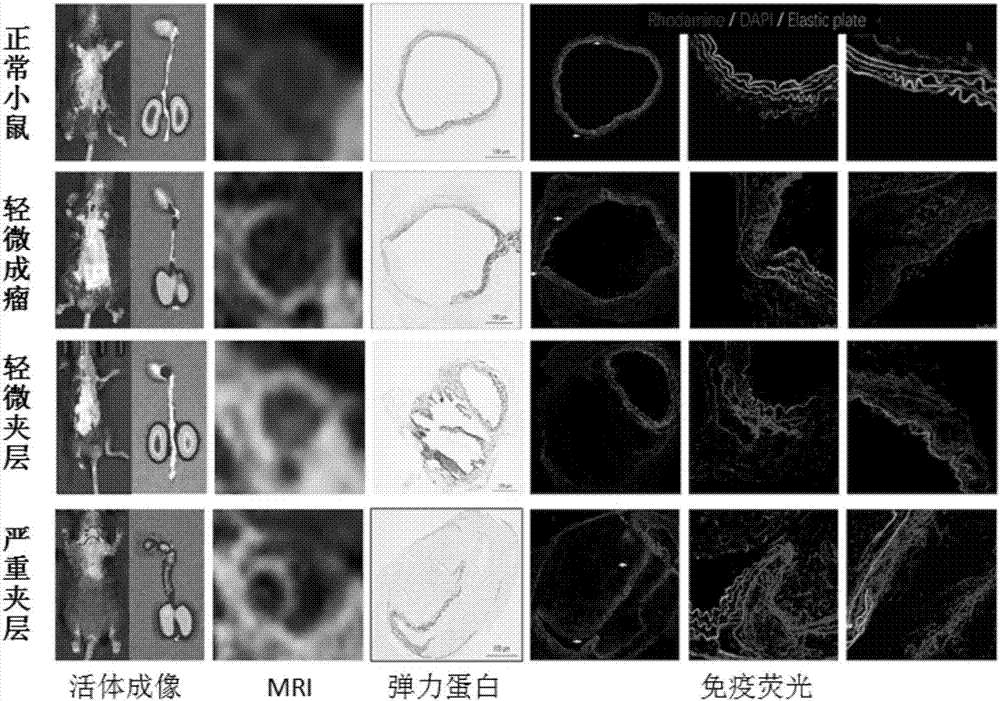Application of tetratype collagen serving as target spot in early-diagnosis of aortic aneurysm/interlayer
A technology for aortic dissection and early diagnosis, applied in the field of diagnosis and treatment of vascular diseases, can solve problems such as high rupture risk and easy torn dissection
- Summary
- Abstract
- Description
- Claims
- Application Information
AI Technical Summary
Problems solved by technology
Method used
Image
Examples
Embodiment 1
[0037] Embodiment 1, the construction of thoracic aortic dissection / aortic aneurysm mouse model (mouse TAD model)
[0038] Construction and evaluation of TAD model in BAPN water-fed mice
[0039] 3-week-old C57BL / 6 background male mice were given normal diet,
[0040] BAPN water-fed group (n=16): BAPN was dissolved in drinking water at a dose of 1 g / kg / day.
[0041] On the 14th day of feeding BAPN, 5 mice were randomly selected for thoracic aortic ultrasound to determine whether there was widening / dissection of the thoracic aorta. After repeated experiments, some mice had formed aortic dissection / aortic aneurysm at 14 days, and began to die one after another.
Embodiment 2
[0042] Embodiment 2, mouse TAD model tissue section detection
[0043] 1. Frozen section:
[0044] At the end of the experiment, the mice were anesthetized with pentobarbital (100 mg / kg), and the heart was perfused with heparinized saline to remove residual blood in the heart. Perfusion was continued with 4% paraformaldehyde to fix the vascular tissue morphology in situ. The arch and descending part of the aorta were separated and clipped under a stereo microscope, soaked and fixed in 4% paraformaldehyde for 2 hours, and then transferred to 30% sucrose solution at 4°C overnight to fully dehydrate. The blood vessel was taken out from the sucrose solution the next day, and the tissue moisture was fully blotted with filter paper, and the blood vessel was vertically embedded in OCT embedding medium, wrapped in tin foil and slowly frozen in liquid nitrogen, which could be stored at -80°C refrigerator. Serial frozen tissue sections, 5 μm in thickness, were mounted on polylysine-c...
Embodiment 3
[0047] Embodiment 3, mouse TAD model histopathological detection:
[0048] I. Observe the condition of the elastic board through elastic fiber dyeing,
[0049] The specific operation is as follows:
[0050] 1.1. Frozen section:
[0051] (1) Wash off OCT in frozen section PBS;
[0052] (2) Add 1 drop (100 μl) of Lugol's iodine solution (reagent A) and incubate for 5 minutes, then wash with water;
[0053] (3) Add 1 drop (100 μl) of sodium thiosulfate (reagent B) for 5 minutes;
[0054] (4) Rinse with running water for 5 minutes, and wash with 70% alcohol;
[0055] (5) Add 1 drop (100 μl) of aldehyde fuchsin staining solution (reagent C), stain for 10 minutes, soak twice with 70% alcohol (about 30 seconds each time, until the section is no longer decolorized), and wash slightly with water;
[0056] (6) Add 1 drop (100 μl) of Orange G dyeing solution (reagent D) for 10 seconds and wash with water;
[0057] (7) 95% alcohol dehydration for 5 minutes;
[0058] (8) Dehydration...
PUM
| Property | Measurement | Unit |
|---|---|---|
| thickness | aaaaa | aaaaa |
| Tensile strength | aaaaa | aaaaa |
Abstract
Description
Claims
Application Information
 Login to View More
Login to View More - R&D
- Intellectual Property
- Life Sciences
- Materials
- Tech Scout
- Unparalleled Data Quality
- Higher Quality Content
- 60% Fewer Hallucinations
Browse by: Latest US Patents, China's latest patents, Technical Efficacy Thesaurus, Application Domain, Technology Topic, Popular Technical Reports.
© 2025 PatSnap. All rights reserved.Legal|Privacy policy|Modern Slavery Act Transparency Statement|Sitemap|About US| Contact US: help@patsnap.com



